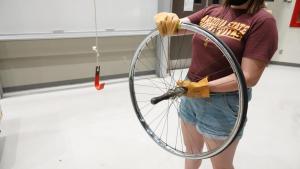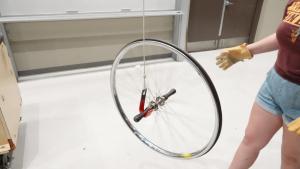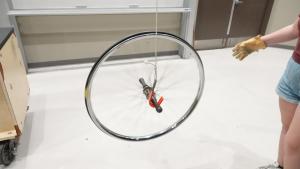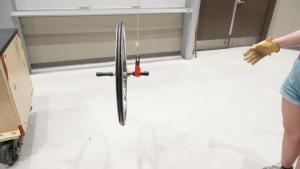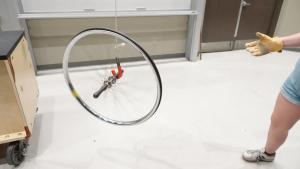Aliases
Bike Wheel Precession
PIRA DCS Number
1Q50.23
Preparation Time
5 minutes
Preparation & Instructions
While one side of the bicycle wheel axle is held, gravity pulls the center of mass of the wheel down applying a torque, thus allowing the axle of the wheel to rotate and fall to the ground.
But what if we spin the wheel? What will happen?
>> Spin the wheel, let it precess
>> Spin the wheel the opposite direction, let it precess in the other direction
So what is happening? We observe the axle of the wheel is still falling like before, but much more slowly. Meanwhile the wheel is also rotating about the axis of the rope it is hanging from.
If we add a mass on one side of the wheel moving upward (velocity vector pointing up) and we know the wheel is going to “fall”, a perpendicular force must be applied by the wheel on the mass to change its velocity to its final velocity (in the horizontal plane). This means a force must be applied on the mass to push it in the direction of its final velocity. But if we recall Newton’s 3rd law, we remember that for a force applied on an object (the mass) there is an equal and opposite force applied on the other (the wheel). This means the mass will apply a force on the wheel in the opposite direction, causing it to rotate. A similar argument can be made for a mass on the opposite side of the wheel. Indeed this is what we observe. This phenomenon is known as gyroscopic precession.
But what if we spin the wheel? What will happen?
>> Spin the wheel, let it precess
>> Spin the wheel the opposite direction, let it precess in the other direction
So what is happening? We observe the axle of the wheel is still falling like before, but much more slowly. Meanwhile the wheel is also rotating about the axis of the rope it is hanging from.
If we add a mass on one side of the wheel moving upward (velocity vector pointing up) and we know the wheel is going to “fall”, a perpendicular force must be applied by the wheel on the mass to change its velocity to its final velocity (in the horizontal plane). This means a force must be applied on the mass to push it in the direction of its final velocity. But if we recall Newton’s 3rd law, we remember that for a force applied on an object (the mass) there is an equal and opposite force applied on the other (the wheel). This means the mass will apply a force on the wheel in the opposite direction, causing it to rotate. A similar argument can be made for a mass on the opposite side of the wheel. Indeed this is what we observe. This phenomenon is known as gyroscopic precession.
